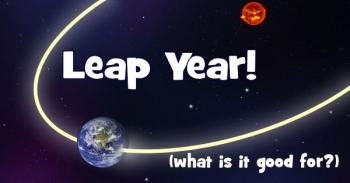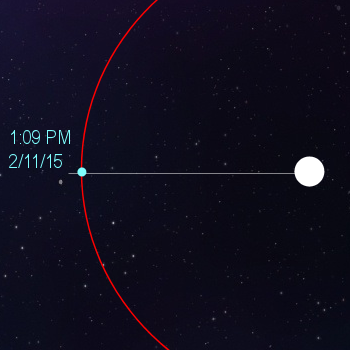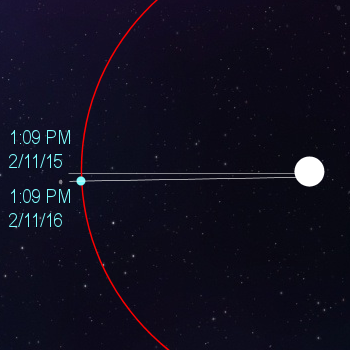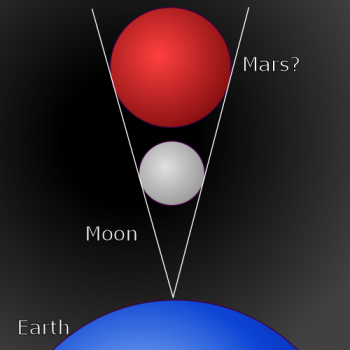Ask Professor Puzzler
Do you have a question you would like to ask Professor Puzzler? Click here to ask your question!
One of my friends shared the following picture on Facebook this morning. He didn't specifically ask me for an answer, but I thought it would be a fun question to explore.

So let's start by asking a question: If it wasn't zero degrees, how would you figure out "twice as cold?" Did you say, "Multiply the temperature by two?"
So, for example, if the temperature was -10 degrees, twice as cold would be -20 degrees?
That seems like it might be a reasonable answer at first glance, except it clearly doesn't work that way, if you just ask this:
If the temperature was 40 degrees, what is twice as cold as that? Now multiply 40 by 2 and you get 80 degrees, which is clearly not colder!
So multiplying the temperature by two doesn't do what we want.
In addition to this, we have another issue with the question: temperature doesn't measure cold. It measures heat. In the same way that we don't measure darkness; we measure light. Amount of light is measured in lumens, and darkness is the absence of light. Cold is not a measured quantity; it is the absence of heat. So saying "twice as cold" may not have any actual meaning to begin with!
The next question to consider is: what scale are you using? Fahrenheit? Celsius? Because that must make a difference too. 0 degrees Celsius is the same as 32 degrees Fahrenheit, and multiplying the first number by 2 gives you zero, while multiplying the second number by 2 gives 64!
Having asked those questions, let's take a break from temperatures and talk about marketing and sales.
I know, I know, that has nothing to do with temperature. Bear with me, though, because I'll get back to temperature in a minute.
Suppose I was hired by a firm to do marketing and sales work. I was hired at the beginning of 2015, and at the end of the year, I wanted to impress my bosses with how much I'd helped the company's bottom line. So I show my boss this chart:

It looks pretty impressive, doesn't it? My boss, if he's not paying attention, will say, "Wow! Look at how much higher the 2015 number is! You've quadrupled our sales, just in one year!"
But if he's paying attention carefully, he'll say, "Wait a minute! Why does your chart's axis start at $12,800 instead of $0?
And the answer is...if my chart started at zero, my bosses wouldn't be nearly as impressed with me:

You see, once we have a frame of reference for comparison, we realize that the difference between the 2015 number and the 2014 number isn't nearly as big as it looked in the first chart. And I certainly didn't quadruple their sales, even though it looked like it in the first chart.
The same is true with temperatures: if you want to make comparisons like "twice" or "half," you really need to have a "real" zero. Zero on the Celsius scale doesn't actually "mean" zero, because zero should mean "no heat at all" (just like zero on my sales chart means "no sales at all"). We need to have a scale in which zero really means "no heat whatsoever."
Fortunately, we have a scale like that. It's the Kelvin scale, in which zero is called "absolute zero" because it is the end of the line. There is no heat whatsoever at zero Kelvin. In the Kelvin scale, 0 Kelvin is equal to -273.16 degrees Celsius, and 273.16 Kelvin is equal to 0 degrees Celsius.
Okay, so now let's make some assumptions. Let's suppose that the guy in the picture means 0 degrees Celsius. Let's also suppose that when he says "twice as cold" he really means "half as much heat energy."
If we make those two assumptions, then we can do the following:
0 degrees Celsius = 273.16 Kelvin
Half of 273.16 Kelvin is 136.58 Kelvin
And 136.58 Kelvin is equal to -136.58 degrees Celsius.
There ya go. If the temperature is 0 (assuming Celsius scale), and it's going to be twice as cold tomorrow, it'll be -136.58 degrees Celsius tomorrow. Of course, we had to make some assumptions along the way, but at least we have an answer!
They say that if my hot chocolate is too hot to drink, I should stir it, because that helps to cool it down. But doesn't stirring increase the temperature by adding friction between the hot chocolate and the spoon?

Interesting question! You are correct that stirring will cause friction. Not just between the spoon and the hot chocolate, but also between the hot chocolate and the mug it's swirling around in. And, unless you are careful to avoid touching the spoon against the mug, there's also friction between the mug and the spoon.
And yes, if that's all that was happening, the temperature of your hot chocolate would rise (although probably not enough that you would notice it!).
But there's something else happening here. Heat is transferring from your hot chocolate to the cooler air above it.
And here's why stirring could make a difference: heat transfers more rapidly when there's a larger temperature difference. You know this, because your house loses heat more quickly in the winter than it does in the spring. If the temperature outside is 0ºC, you'll lose heat more rapidly than if the temperature was 15ºC.
Similarly, your hot chocolate is losing heat to the air above it. The air above your mug is warming up, while the hot chocolate is gradually cooling down.
The problem is, your hot chocolate is not losing heat uniformly. The surface is cooling down rapidly, while deep in the mug it's still very hot. You can test this for yourself. Scoop a spoonful of hot chocolate from the surface and drink it, then take a spoonful from deeper in the mug. You'll find that the deeper spoonful is hotter. So the surface is cooling rapidly, while underneath it is not. As the surface of your hot chocolate cools down, and the air warms up, the temperature difference is decreasing. And if the temperature difference is decreasing, that means that the rate of heat loss is decreasing.
Meanwhile, the deeper-down hot chocolate is gradually losing heat to the cooler upper layer, but that's a slow process.
How to speed that process up? Stir your hot chocolate occasionally! That'll bring some of the hotter beverage to the surface. Now you'll have a higher temperature difference, and the rate of heat loss will increase.
Incidentally, while we're on the subject of heat loss, you can also help your hot chocolate cool down faster by moving it around on the table periodically. After all, every time you move it away from the air it has heated up, to cooler air, you've increased the temperature difference again. Will that significantly increase the rate of cooling? Probably not, but it'll make you feel like you're doing something useful while you wait, which is probably the real reason people stir in the first place!
Jakob saw a multiple choice question on a website, and was surprised by the answer. He was curious to know what Professor Puzzler thought.
Here's the question: You have an iron rod which is 1 light year in length. You push one end of the rod. How long does it take before the other end moves? The options are:
A: Immediately
B: 1 week
C: 1 year
D: at least 1,000 years.
The "instinctive" answer is to say A - the moment you move one end is the moment the other end moves. And, as you might guess, from the fact that we're being asked to explain it, A is not correct.
To help understand what's happening here, I'd like you to imagine that the rod is not made of iron. I want you to imagine instead that it's made of marshmallow. Yes, that's right - one single marshmallow that's 1 light year tall.
Now imagine what happens when you push one end. Can you visualize it? As you push, the marshmallow rod compresses (squishes) right by where you pushed it. Of course, it won't stay compressed, and since it can't "rebound" to its original position (your hand is in the way, and you're still pushing), the compressed section will decompress by pushing the compression down the length of the rod. In other words, you'll create a wave of compressed marshmallow that will travel the length of the rod.
"Ah, yes," you might say, "but that's marshmallow. A marshmallow is squishy. An iron rod isn't squishy. It's rigid."

Well, yes and no. It's kind of like "The Princess Bride," where Miracle Max concludes that "mostly dead is partly alive." Iron is "mostly rigid," and mostly rigid is partly squishy. It will compress. The motion of the rod is actually a wave of motion, just like with the marshmallow. The other end of your rod will move after you've pushed your end.
How much after? Well, that's a good question. And I don't know the answer. But I do know this: the speed of that wave is significantly slower than the speed of light. And how long does it take light to travel the length of the rod? Since the definition of a "light year" is "the distance light will travel in a year," we can conclude that light takes a year to travel the length of the rod. And therefore, the amount of time it takes for the other end of the rod to move is more than a year. If you look at your possible answers, D is the only one that is more than a year. Therefore, if any of the answers are correct, D must be the one!
It seems counter-intuitive; when you are dealing with much smaller "mostly rigid" objects, it appears to you as though the other end moves simultaneously with the end you pushed. The key is the word "appears." There is actually a tiny, tiny delay, which is so short you couldn't possibly measure it. But when you are dealing with such an astronomical distance (the length of your rod is 63 thousand times the distance from the earth to the sun!), that tiny, tiny delay is suddenly not tiny any more!
Incidentally, I hope you're planning to push very very hard, if you intend to move that rod of yours any significant distance. If we assume that the radius of the rod is 1 centimeter, its mass is about 23 quadrillion kilograms, which would make for a decent sized asteroid, if it wasn't so oddly shaped!
Leap year! What is it good for? Absolutely nothing? Or does it actually serve a purpose?
Okay, let me explain how this question came about...

Today our little girl turned one year old. She was born at 1:09 in the afternoon on February 11th, 2015. I mentioned this to my Algebra students today, and then added that at about 7:09 this evening, she will have completed one entire revolution around the sun.
They looked at me like I had a third eye growing out of the middle of my forehead (okay, they often look at me that way...). "If she was born at 1:09 in the afternoon, isn't that when she's finished her first revolution around the sun?"
Nope! You see, a year is not exactly 365 days long. A year (the amount of time it takes for the earth to travel once around the sun) is actually a little bit longer than 365 days. It's right around 365.25 days. So our little girl finished her first trip around the sun a quarter of a day after her birth hour. Since a quarter of a day is 6 hours (24/4 = 6), and 7:09 is six hours after 1:09, it was this evening that she finished her first trip around the sun.
This led the class into a discussion of leap year, because that quarter of a day is the reason why leap years exist. If our calendar year is a quarter of a day shorter than a solar year (a solar year is the time it takes earth to travel once around the sun), then every four years, we'll end up with an extra day that needs to be stuffed into the calendar somewhere. So we decided to make that day be February 29th. It was actually very good thinking - since February was by far the shortest month, putting that extra day in the calendar in February helps to even out the months a little*.
"Of course," I added, "It's not exactly that simple, because a solar year is not exactly 365.25 calendar days. It's just a little bit less than that. Which is why, every hundred years, we skip a leap year."
"WHAT?"
"Oh yes. If the year number is divisible by 100, we don't have a leap year."
"Really?"
"Sure. Unless, of course, the year is also divisible by 400. In that case, we do have leap year."
It was at this point that one of my students suggested that Leap Year might be good for absolutely nothing. Actually, what she said was, "I don't see why we need to do all this math. Why can't we just forget leap year?"
Ah. Good question. Let me try to explain it to you. Take a look at the picture below. In it you'll see the sun, and planet earth. Earth is following that almost-circular orbit around the sun, and I've marked the position of the earth with the time: the time of my little girl's birth.

When the earth is in this position, we are essentially in the dead of winter.
Now, where will the earth be 365 days after this point in time? I'll show you. In the picture below I've marked 1:09 PM on Feb 11, 2016. That's the second line I've drawn. "That's it?" you might think. "Why that's hardly any difference at all!"

Sure, that's true. But that tiny little difference (about a quarter of a degree every year) will add up as the years pass.
Suppose we stop having leap years. And suppose that my little girl lives to be 120 years old (hey, who knows what scientific advances will happen in her lifetime?). When she's 120 years old, all those quarter days will have added up to an entire month. She'll be celebrating Christmas on December 25th, but the weather will be like Thanksgiving weather instead of Christmas weather, because the calendar year will have shifted an entire month from the solar year - and it's the solar year that determines our seasons, regardless of what we declare them to be on our calendar!
Can you imagine? She'll say to her great-grand kids, "I remember when we used to have blizzards on Christmas..." and they'll say, "That's silly, gram! We never have snow like that in December!"
And then, if we keep on like this, all those quarter-days will add up to 2 months, then 3. Eventually, our calendar year will be completely backwards from the solar year. Students will have June, July, and August off from school, and it will be snowing and bitter cold all through "summer" vacation. Then they'll be going to school all through the wonderfully warm and sunny beach weather of December, January, and February.
"Okay," my student said, "We can keep leap year."
I thought you might feel that way.
* Professor Puzzler's father, commonly known around here as "Mr. Physics," adds the following leap-year trivia:
"There is another reason whey they choose February for the extra day. Remember, under the Julian calendar the year started at March; February was the last month of the year. That is why September (7), October (8), November (9) and December (10) are numbered wrong.
"Another interesting bit of trivia. When Caesar Augustus decided that he needed a month named for him (August) he realized that to show himself equal to his Great Uncle Julius he needed to have 31 days in August so he stole a day from February leaving it with only 28 days."
It's been showing up in social media - on August 27th, 2015, there will be an amazing sight in the night sky; there will be a double moon! Why? Because Mars will appear as big as the moon on that day.
True? Or hoax?
Professor Puzzler says: HOAX!
Take a look at the image below to get a better idea of how crazy that would be:

In the picture you can see (roughly) the scaled sizes of Mars and the moon. Surprisingly, mars is only twice as big in diameter as the moon. (The distances are not on the same scale as the sizes, since that would result in a picture with a cone almost too narrow to see.)
In order for Mars to appear the same size as the moon, it needs to fit snugly inside the visual cone with apex on the surface of planet earth (where you're standing, looking into the night sky).
We could draw some similar triangles connecting the apex, the tangents to the two bodies, and the centers of the two bodies; since these are similar triangles, they have to have the same side ratios. What does that mean? It means that if the radii are in the ratio 1:2, the distances have to be in the ratio 1:2.
In other words, Mars would be about 500,000 miles from planet earth. Since, at its very closest, Mars is about 30 million miles from planet earth, Mars is going to somehow have to teleport itself a few million miles out of its orbit to appear that big to us on its one-night engagement as the moon's twin brother.
Of course, this sudden, dramatic appearance of a new celestial body in our orbit is going to cause some pretty drastic effects, including - I would imagine - significant tidal forces, volcanic eruptions, and earth quakes.
Let's hope this isn't going to actually happen!
[And presumably, after its one night visit, Mars is going to somehow teleport itself back, which will result in more gravitational disturbances the next day!]

